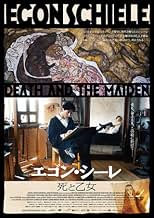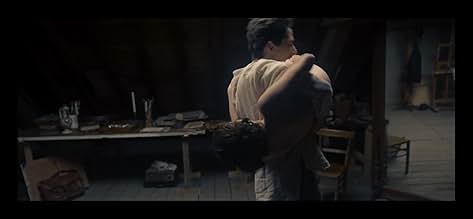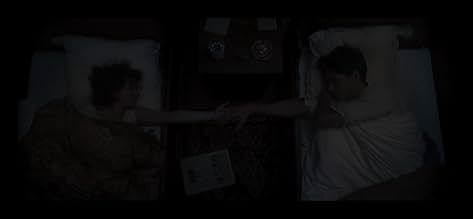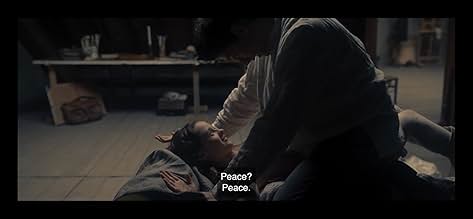IMDb RATING
6.5/10
1.6K
YOUR RATING
Vienna, early 20th century: the young Egon Schiele is one of the most discussed artists of his time with his original, erotically charged works.Vienna, early 20th century: the young Egon Schiele is one of the most discussed artists of his time with his original, erotically charged works.Vienna, early 20th century: the young Egon Schiele is one of the most discussed artists of his time with his original, erotically charged works.
- Awards
- 7 wins & 10 nominations total
Larissa Breidbach
- Moa Mandu
- (as Larissa Aimée Breidbach)
- …
Featured reviews
A biopic of Austrian painter Egon Schiele (1890-1918), what instantaneously catches our eyes is the pulchritude of its leading actor Noah Saavedra, whose Adonis appearance becomes almost too distracting for the movie's own good, but it shouldn't take the credit away from Saavedra's immersed embodiment of the ill-reputed expressionist, who leaves a vast legacy to this world after his own ephemeral and turbulent life.
After opening the picture with a frenzied sequence of some sort of familial turmoil and envisaging a moribund Schiele smitten with the Spanish flu pandemic in his last days, director Dieter Berner discerningly unspools Schiele's final decade chronologically through the relations with his models: from his underage sister Gerti (Riegner), with whom he forms an intimate bond teetering on the brink of incest, to a tableau-vivant performer Moa (Breidbach), then his bona-fide muse Wally Neuzil (Pachner), whom he first encounters in the studio of his mentor Klimt (Obonya), until his ill- matched bourgeois wife Edith Harms (Marie Jung), only to coyly divulge Schiele's feckless penchant towards his conquests, chiefly for the sake of artistic inspiration and utilitarian purpose, art first, women second, seems a fitting watchword for him.
It is Egon and Wally's romantic liaison highlights the narrative, and a sylph-like Valerie Pachner gives her best in projecting Wally's emotional gamut out of their artist-and-muse equilibrium, in particular during Schiele's scandalous trial of pornography and pedophilia (another taboo topic subjected to an ambiguous brush), her conflicted reaction stays with audience longer than the artist's outrage of witnessing one of his paintings being torched. But Berner ultimately sweetens the pill of their fallout, which prompts the name-change of the film's titular painting, out of the reverence to Egon's posthumous fame.
As picturesque as a painter's biopic could ever be, Berner's diligent but anodyne work doesn't pack a substantial punch which would be in concordance with his subject's singularities, especially that unique characteristic stemming from his licentious, tempestuous persona, still eludes us after him shuffling off this mortal coil.
After opening the picture with a frenzied sequence of some sort of familial turmoil and envisaging a moribund Schiele smitten with the Spanish flu pandemic in his last days, director Dieter Berner discerningly unspools Schiele's final decade chronologically through the relations with his models: from his underage sister Gerti (Riegner), with whom he forms an intimate bond teetering on the brink of incest, to a tableau-vivant performer Moa (Breidbach), then his bona-fide muse Wally Neuzil (Pachner), whom he first encounters in the studio of his mentor Klimt (Obonya), until his ill- matched bourgeois wife Edith Harms (Marie Jung), only to coyly divulge Schiele's feckless penchant towards his conquests, chiefly for the sake of artistic inspiration and utilitarian purpose, art first, women second, seems a fitting watchword for him.
It is Egon and Wally's romantic liaison highlights the narrative, and a sylph-like Valerie Pachner gives her best in projecting Wally's emotional gamut out of their artist-and-muse equilibrium, in particular during Schiele's scandalous trial of pornography and pedophilia (another taboo topic subjected to an ambiguous brush), her conflicted reaction stays with audience longer than the artist's outrage of witnessing one of his paintings being torched. But Berner ultimately sweetens the pill of their fallout, which prompts the name-change of the film's titular painting, out of the reverence to Egon's posthumous fame.
As picturesque as a painter's biopic could ever be, Berner's diligent but anodyne work doesn't pack a substantial punch which would be in concordance with his subject's singularities, especially that unique characteristic stemming from his licentious, tempestuous persona, still eludes us after him shuffling off this mortal coil.
It is always complicated to convey the essence of a great artist through cinema or TV.
This film is simple and delicate. The main actor is very intense and does a wonderful job in portraying Egon Schiele. All of the actors are very good, really. Unfortunately, their performances are not enough to elevate the film much above mediocrity. However, if the author fails to catch the true spirit of such an extraordinary and revolutionary genius, he succeeds in depicting the profound sense of melancholy and sadness, uncertainty and disenchantment that permeated Europe throughout First World War.
This film is simple and delicate. The main actor is very intense and does a wonderful job in portraying Egon Schiele. All of the actors are very good, really. Unfortunately, their performances are not enough to elevate the film much above mediocrity. However, if the author fails to catch the true spirit of such an extraordinary and revolutionary genius, he succeeds in depicting the profound sense of melancholy and sadness, uncertainty and disenchantment that permeated Europe throughout First World War.
Biopic of expressionist artist Egon Schiele. It's a little artsy (!) but all in all pretty good. What exquisite bodies the two females who play his main models are endowed with. The movie tells his story with a good flow; it makes me want to read up on his life.
I've always been in love with Egon Schiele's work. He's probably my favourite painter. So, I was a bit skeptical about this film. But I loved it! The cinematography is beautiful, the performances are great (especially Noah Saavedra, Maresi Riegner, and Valerie Pachner), and the music is sublime. Egon produced in his short life around 300 canvases and around 2,000 water colours and drawings. And they are all amazing. I would have preferred a bit more about the paintings and less of the women, but overall, it's a wonderful film. Egon Schiele: Tod und Mädchen is a beautiful, erotic, sad, and poetic film. A real gem. 10/10.
Precise, powerful, delicate. Egon Schiele and the women of his life. Admirable performance of Noah Saavedra, flavors of Austria of Belle Epoque, wise use of biographic details. Could it be better ? Off course ! But, in the case of Schiele, it is difficult or too subjective to define this better. The film has the precious gift to be a correct one. A good invitation to discover the fascinating universe of the art of Egon Schiele. A sketch, maybe, but, obvious, an inspired one, reflecting care and science and admiration for the great artist. Not a story about a genius but portrait of an exceptional young man and his reflections of emotions in a special, profound special art. So, a beautiful sketch.
Did you know
- TriviaThe trailer for the movie was blocked on Facebook for the reason of nudity.
- GoofsDuring several closeups it can be seen that Noah Saavedra (Egon) and Valerie Pachner (Wally) are wearing contact lenses. The distinctive transparent rings around the irises are clearly showing.
- Quotes
Egon Schiele: You can't buy art. Art is invaluable.
- ConnectionsReferences Der Hirt von Maria Schnee (1920)
- How long is Egon Schiele: Death and the Maiden?Powered by Alexa
Details
- Release date
- Countries of origin
- Official sites
- Language
- Also known as
- Egon Schiele: Death and the Maiden
- Filming locations
- 101 Hietzinger Hauptstrasse, Vienna, Austria(Schiele's Atelier exterior)
- Production companies
- See more company credits at IMDbPro
Box office
- Budget
- €4,700,000 (estimated)
- Gross worldwide
- $598,929
- Runtime1 hour 50 minutes
- Color
- Aspect ratio
- 2.35 : 1
Contribute to this page
Suggest an edit or add missing content



























